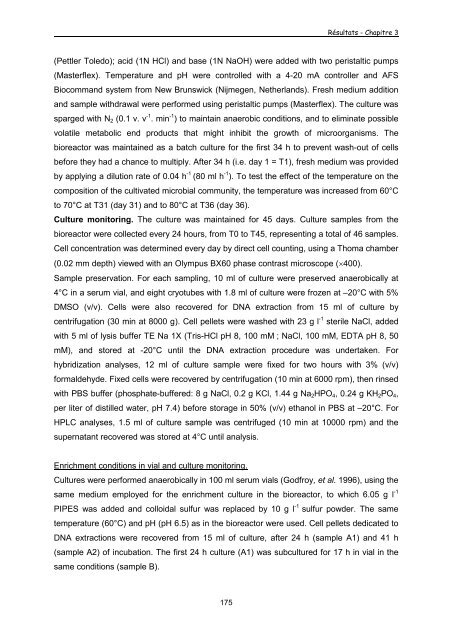THESE Anne POSTEC Diversité de populations microbiennes ...
THESE Anne POSTEC Diversité de populations microbiennes ...
THESE Anne POSTEC Diversité de populations microbiennes ...
Create successful ePaper yourself
Turn your PDF publications into a flip-book with our unique Google optimized e-Paper software.
Résultats - Chapitre 3<br />
(Pettler Toledo); acid (1N HCl) and base (1N NaOH) were ad<strong>de</strong>d with two peristaltic pumps<br />
(Masterflex). Temperature and pH were controlled with a 4-20 mA controller and AFS<br />
Biocommand system from New Brunswick (Nijmegen, Netherlands). Fresh medium addition<br />
and sample withdrawal were performed using peristaltic pumps (Masterflex). The culture was<br />
sparged with N 2 (0.1 v. v -1 . min -1 ) to maintain anaerobic conditions, and to eliminate possible<br />
volatile metabolic end products that might inhibit the growth of microorganisms. The<br />
bioreactor was maintained as a batch culture for the first 34 h to prevent wash-out of cells<br />
before they had a chance to multiply. After 34 h (i.e. day 1 = T1), fresh medium was provi<strong>de</strong>d<br />
by applying a dilution rate of 0.04 h -1 (80 ml h -1 ). To test the effect of the temperature on the<br />
composition of the cultivated microbial community, the temperature was increased from 60°C<br />
to 70°C at T31 (day 31) and to 80°C at T36 (day 36).<br />
Culture monitoring. The culture was maintained for 45 days. Culture samples from the<br />
bioreactor were collected every 24 hours, from T0 to T45, representing a total of 46 samples.<br />
Cell concentration was <strong>de</strong>termined every day by direct cell counting, using a Thoma chamber<br />
(0.02 mm <strong>de</strong>pth) viewed with an Olympus BX60 phase contrast microscope (×400).<br />
Sample preservation. For each sampling, 10 ml of culture were preserved anaerobically at<br />
4°C in a serum vial, and eight cryotubes with 1.8 ml of culture were frozen at –20°C with 5%<br />
DMSO (v/v). Cells were also recovered for DNA extraction from 15 ml of culture by<br />
centrifugation (30 min at 8000 g). Cell pellets were washed with 23 g l -1 sterile NaCl, ad<strong>de</strong>d<br />
with 5 ml of lysis buffer TE Na 1X (Tris-HCl pH 8, 100 mM ; NaCl, 100 mM, EDTA pH 8, 50<br />
mM), and stored at -20°C until the DNA extraction procedure was un<strong>de</strong>rtaken. For<br />
hybridization analyses, 12 ml of culture sample were fixed for two hours with 3% (v/v)<br />
formal<strong>de</strong>hy<strong>de</strong>. Fixed cells were recovered by centrifugation (10 min at 6000 rpm), then rinsed<br />
with PBS buffer (phosphate-buffered: 8 g NaCl, 0.2 g KCl, 1.44 g Na 2 HPO 4 , 0.24 g KH 2 PO 4 ,<br />
per liter of distilled water, pH 7.4) before storage in 50% (v/v) ethanol in PBS at –20°C. For<br />
HPLC analyses, 1.5 ml of culture sample was centrifuged (10 min at 10000 rpm) and the<br />
supernatant recovered was stored at 4°C until analysis.<br />
Enrichment conditions in vial and culture monitoring.<br />
Cultures were performed anaerobically in 100 ml serum vials (Godfroy, et al. 1996), using the<br />
same medium employed for the enrichment culture in the bioreactor, to which 6.05 g l -1<br />
PIPES was ad<strong>de</strong>d and colloidal sulfur was replaced by 10 g l -1 sulfur pow<strong>de</strong>r. The same<br />
temperature (60°C) and pH (pH 6.5) as in the bioreactor were used. Cell pellets <strong>de</strong>dicated to<br />
DNA extractions were recovered from 15 ml of culture, after 24 h (sample A1) and 41 h<br />
(sample A2) of incubation. The first 24 h culture (A1) was subcultured for 17 h in vial in the<br />
same conditions (sample B).<br />
175
















